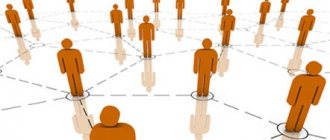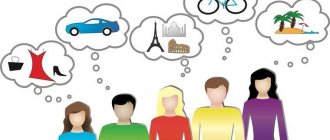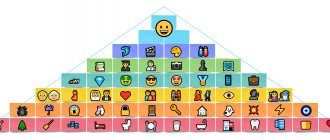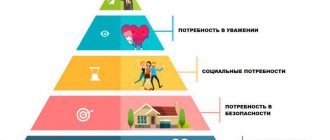Existence needs usually include physiological and safety. We believe that the needs of belonging should also be classified as this type. This is determined by the fact that a person cannot exist for any long time outside of any group (in particular, a family).
The following main levels of satisfying the needs of existence can be distinguished: 1) minimal, 2) basic, 3) luxury level.
The minimum level of satisfaction of the needs of existence ensures human survival.
The basic (normal) level provides the opportunity for the emergence of significant intellectual and spiritual needs. This level can be determined both subjectively and objectively. In the first case, the criterion for achieving the basic level is the time that a person is occupied with thoughts about meeting the needs for food, clothing, housing and security. It is advisable to assume that this time should not exceed half of the waking time. An objective assessment of the basic level can be the consumer budget, which experts consider necessary for various types of activities. In particular, the work of miners is among the most intense and dangerous. Therefore, the costs of food and rest for miners are objectively higher than for office personnel.
The level of luxury is proposed to be considered one in which the satisfaction of the needs of existence above the basic level becomes an end in itself and/or a means of demonstrating a high social status. At the level of luxury, a person “lives to eat, not eats to live.” Characteristics of an appropriate lifestyle are available in the works of A. Marshall, T. Veblen and many other authors.
Thus, Marshall has the following statements: “Laws against luxury have been in vain, but it would be a great achievement if the moral spirit of society could induce people to avoid all forms of boasting of individual wealth.” “...The world would be much more perfect if everyone bought fewer and simpler things, tried to choose them from the point of view of their true beauty; ...to consider the effect upon the general welfare of the manner in which each individual spends his income is one of the most important tasks of the practical application of economics to the way of life of men.”
For most people, the level of satisfaction of physiological needs significantly affects the structure of intellectual, social and spiritual needs. At the same time, it has been known since ancient times that the less a person is focused on material wealth, the more freedom he has from life’s circumstances and the powers that be. All great philosophers and religious figures - those who are commonly called Teachers of humanity - called for a reasonable limitation of physiological needs.
Thus, after achieving the basic level of satisfying the needs of existence, the needs to achieve life goals are formed, which, it is advisable to differentiate into four groups: 1) material benefits for the individual and family; 2) power and glory; 3) knowledge and creativity; 4) spiritual improvement.
Depending on individual inclinations, abilities and aspirations, in some people, after achieving the basic level of satisfaction of the needs of existence, the desire to maximize the consumption of material goods will dominate; for others - to power and glory; for others - to knowledge and creativity; for others - to spiritual improvement.
The structure of human needs is highly individual, which must be recognized in every attempt to understand someone's motivation. The relative importance of specific needs changes over time as individuals' commitments and interests change. Thus, for young people or individuals whose partners have high incomes, security needs come last. In addition, human needs often conflict.
The process of transforming human needs into behavior is no less individual. For example, an individual with a high need for responsibility or advancement will satisfy this need by obtaining a transfer to another department. And someone will decide to change their occupation.
What are needs
The key word in defining the concept of need is “need”.
Read also: Bash.im - Wikipedia Reprint
Need
is the need for certain things, objects of the material world, objects, people, social indicators, in the absence of which a person feels uncomfortable.
Taking into account this definition, neediness, in order to become a need, must meet the following criteria:
- A lack of need causes a feeling of dissatisfaction. A need is something desired, a good.
- Accompanying with emotions: from negative at the first stage to joyful after the need is fulfilled. When we really want something, we get nervous and anxious; when we get what we want, we relax.
- Fixation on the subject of need. Consciousness snatches from reality those things that can satisfy us. For example, if we are hungry, we will focus on the food and the smell of food.
The system of needs is also formed according to special rules:
- Need is common to all living beings on the planet. But the more developed the species, the higher the level of needs. The tree has enough nutrients from the soil, sunlight, and rain watering. Man, as a highly developed animal, needs much more.
Read also: How to craft a frost moon in terraria
- The older the person, the more extensive the list of what is required. A baby can do without things that an adult needs.
- Needs are a strictly hierarchical structure, some are primary, others are secondary.
People's actions are dictated by the presence of a certain need, which is the main motivator of activity. Motivation to get what you want moves a person forward and forces him to act. Everything that has been created by people throughout the history of mankind in politics, economics, art, science is the result of activities to satisfy needs.
Types of human needs
Needs can be divided into two types: innate and acquired.
Innate are those with which a person came into this world. The baby cannot do without food, water, air. He needs to feel that his mother is nearby and takes care of him. It is necessary that the room is warm, otherwise it will freeze. Even an adult cannot live without basic needs. He also needs to eat, sleep, and breathe.
Acquired are those that appeared as a result of interaction with the social environment. For example, they will be different if a person grew up in a poor and rich family. Some will be happy if they are given sausage sandwiches for breakfast instead of oatmeal, while others will be offended if they are given a two-room apartment instead of a townhouse. If suddenly the realities of life change, and a person accustomed to luxury is left without the usual big money, then he will experience severe discomfort, even if he has the opportunity to satisfy basic needs.
Classification of desires according to A. Maslow
If you find out that a person has a need for shelter, food and a healthy lifestyle, then you have identified a primary need. Need forces an individual to strive to obtain essential benefits or change an undesirable situation (disrespect, shame, loneliness, danger). The need is expressed in motivation, which, depending on the level of personal development, takes on a specific and definite form.
Primary needs include physiological needs, for example, procreation, the desire to drink water, breathe, etc. A person wants to protect himself and his loved ones from enemies, help them treat diseases, and protect them from poverty. The desire to get into a certain social group sends the researcher to another category - social needs. In addition to these aspirations, the individual feels a desire to be liked by others and demands respectful treatment.
Human needs are constantly changing; in the process of human evolution, motivation is gradually being revised. E. Engel's law states that the demand for low-quality food products decreases as income increases. At the same time, the demand for food products, which are required of increased quality while improving the standard of human life, is increasing.
Types and purposes of means to meet needs
Products act as means of satisfying needs. We can talk about a broad and narrow definition of the concept of “product”. In a broad sense, all means of satisfying needs offered in the market and its various segments are classified as goods. Historically, it has developed that services, money, securities, labor resources, information, ideas, which are specific goods, are usually identified as independent types of means of satisfying needs. Goods usually include only material products (“things”) offered on the market, i.e. in the narrow sense of this term. However, when considering the characteristics of other means of satisfying needs, one can see that they have much in common with goods.
Goods in the form of physical objects include raw materials, supplies, semi-finished products, components and finished products. They are able to satisfy the most diverse needs of individual, industrial and managerial consumers, relating to all the previously listed types and varieties of needs. Thus, most food products satisfy physiological and mental (organoleptic) needs. However, prestigious goods (caviar, meat and fish gastronomy) also satisfy social needs. Tobacco products satisfy mainly mental and sometimes social needs (as a way of communication). Non-food products satisfy physiological and social needs (clothing and footwear), mental, intellectual and spiritual needs (cultural, household, book and similar goods).
Services, like goods, can simultaneously satisfy one or two, or less often three, types and/or varieties of needs. Thus, the food service satisfies physiological, social and mental (organoleptic, ergonomic) needs, and the retail service satisfies only the last two types of needs. Medical, health, sports, tourism and similar services are designed to satisfy recreational and safety needs.
Technologies are designed to produce goods and services that will satisfy a variety of individual and societal needs. However, the technologies themselves directly satisfy social needs (economic, labor and technological, necessary for the life support of society as a whole, industrial and individual consumers). . Technologies act as a means to meet the needs of industrial consumers in the capital goods market.
Money and securities fulfill a social purpose and, accordingly, satisfy social needs (prestigious, economic, life support for society and individual consumers). This is explained by the peculiarity of money and securities that perform the functions of an equivalent of goods and services in commodity-money exchange. It is money and other financial means that replace it (credit cards, bank checks, etc.) that help transform needs into demand. In addition, money and securities serve as a means of accumulating and satisfying predicted and deferred needs (for example, for large purchases, vacations, ensuring future expenses).
Labor resources (management, management, production and service personnel) are a means of satisfying needs in the labor market. Since the objects of labor activity of management and personnel are tangible and intangible products, services, technological processes, as well as lower-level personnel, their professional activities require competence in certain areas. As a result, educational and information needs arise related to the training and development of personnel and management. Users of labor resources in the labor market are industrial consumers (manufacturers or service providers), state and local governments, public associations and organizations, as well as individual entrepreneurs. Labor resources (management and personnel of the organization) in the process of work create products, which all or most of them become goods, or provide services. Thus, labor resources are involved in meeting the needs of various consumers, including individual ones.
Information directly or indirectly satisfies the needs of all categories of consumers: public and individual in the market of information products, services and technologies (for example, the development and sale of computer programs). Information that is not related to a specific object is meaningless and of no interest. Information is always about something or someone: about goods, services, money, securities, politicians, athletes, etc. It is a kind of multifunctional product or service: it functions as a means of not only satisfying informational, educational and spiritual needs, but also the promotion of goods to the market, as well as a means of communication that allows them to generate demand. Information performs these functions due to its main purpose - satisfying intellectual, in particular information, needs. Thanks to this, information ensures that all other types of means of satisfying needs are communicated to the consumer.
Ideas satisfy many needs. They underlie the creation of all goods, services, etc. For example, the computer appeared as a result of the idea of the need to create a machine to increase the speed and quality of information processing. The development of the restaurant business is based on the idea of the need to save consumers’ time in preparing food, and the development of entertainment establishments (theaters, sports organizations, etc.) is based on the organization of leisure for consumers. Industrial consumers are more interested in buying ideas, since they allow them to launch new goods and services on the market based on them. At the same time, all categories of consumers, when purchasing goods and services, simultaneously buy the ideas embedded in them.
Product (product and its characteristics);
1.Product offer.
The product offering has consumer value and cost. Consumer value allows you to satisfy the needs of customers and is a combination of such characteristics assortment, quality, quantity, etc. In addition, a product offering as an object of purchase and sale may have a certain value. Price helps create consumer preferences and is a measure of the consumer value of a product offering.
The product offering can be viewed in terms of five levels:
1. Key value is the main service (Advantage) that the buyer purchases.
A person who comes to a bakery for bread buys food that can satisfy his hunger. With the same success he could buy potatoes, meat or other food products.
The task of a market worker is to identify the needs hidden behind any product and sell not the properties of this product, but the benefits from it ( better satisfaction of needs, lower price, more convenient service
)
2. The main product is a product offered for sale with a set of certain characteristics. The main product can have five characteristics:
· Quality level
· Set of properties
· Specific design
· Brand name
· Specific design
The task of enterprises is to provide the product with all the necessary characteristics so that the consumer can compare them with the parameters of their needs and decide whether the product will satisfy it.
3. Expected product - a set of characteristic features and conditions that the consumer usually expects and to which the consumer usually expects and to which he usually agrees when purchasing this product. When purchasing bread, a person expects freshness, a pleasant aroma, a certain composition indicated on the package.
The task of marketers is to identify all consumer expectations and determine whether the product has them or not; if not, then the product must be improved.
4. An improved product meets needs beyond normal expectations. The main goal is to identify unconscious needs, predict their changes and release them to the market before competitors.
For example, bread is cut into pieces and packed in vacuum packaging. The magazines come with a disc as an attachment, etc.
· Any improvement requires additional costs, therefore, you need to find out whether buyers are ready to pay for them
· An improved product after some time turns into the expected one, so the market offer should be constantly improved.
· Since improved products are more expensive, there will always be competitors who focus on the main product, intended for consumers in need of a cheap product.
5. Potential product - associated with those improvements and transformations that an existing product may undergo in the future.
A need is not just a desire, it is a need. And the need cannot be satisfied
Even if you don't find a toilet, you still have to do “this”. Therefore, if the need is not directly recognized and satisfied, it is satisfied indirectly, bypassing awareness. The most popular way to get support and love is to get sick. And with the help of a serious illness you can gain more respect and recognition. This is not about simulation. People get very seriously ill, without even realizing that all they want is to get the attention, care and respect of loved ones. When there is no opportunity to recognize your needs and take responsibility for meeting them, then this responsibility is transferred to the body. And psychosomatics becomes a common solution. When realizing (not denying) the need, a clear chain is built:
When one logically follows from the other. That’s why it’s so important in coaching, for example, to trace where the goal came from.
What need does a person realize in this way? Why is it important? Was the target taken from the ceiling? Will a person go to her, will he understand why?
Differences between needs and wants
Needs and desires are not the same thing. There are differences.
| Needs | Desires |
| 1. Needs are always constructive. Human needs indicate the importance and primacy of their satisfaction for the possibility of further functioning and life. 2. The basis of the need is always something important and deep. 3. Thanks to the satisfaction of needs, a person finds harmony with himself. | 1. They are destructive in nature. May harm personal development and life. So, drug addiction is a “wish”, not a need. 2. Other people can impose “wants.” 3. Desires may be superficial and not satisfy the true needs of a person. |
Let's try to figure it out with an example. Imagine that you live in your own apartment and dream of a summer house. You don't have enough money to buy a summer house, so you're angry. In this case, giving is a desire. But if you have nowhere to live, then buying any housing is satisfying a need.
Why is it necessary to distinguish between needs and desires? This is necessary for proper distribution of energy and resources. It also makes it possible to better understand yourself and others. Well, besides, seeing the differences, a person will be able to set priorities correctly.
To make the task easier, just honestly answer the following questions:
- Is it possible to do without this? A fashionable dress is a desire, but not a need. You can put it aside and buy it when there are enough opportunities for this.
- What will I get? The answer to this question will help you understand the nature of the origin of what you want.
- Will this purchase limit me? Desires should not interfere with the satisfaction of needs. Always prioritize.
Motive of behavior
The existence of needs is judged by a person’s deeds and behavior. Needs and aspirations are referred to as quantities that cannot be directly measured and observed. Researchers in the field of psychology have determined that certain needs motivate an individual to act. The feeling of need forces a person to act to satisfy needs.
Drive is defined as a lack of something that turns into a certain course of action and a person concentrates on achieving the result. The result in its final manifestation means a means to satisfy desire. If you achieve a certain goal, it may mean complete satisfaction, partial or incomplete. Then determine the ratio of primary and secondary needs and try to change the direction of the search, while leaving the motivation the same.
The amount of satisfaction obtained as a result of an activity leaves a mark on memory and determines the behavior of the individual in the future under similar circumstances. A person repeats those actions that caused the satisfaction of primary needs, and does not commit actions leading to failure to fulfill his plans. This law is called the law of result.
Managers in modern society model situations that allow people to feel satisfaction through behavior that benefits them. For example, a person in the process of production activity must imagine the completion of work in the form of a meaningful result. If the technological process is structured in such a way that the individual does not see the final result of the work, this will lead to the disappearance of interest in the activity, violation of discipline and absenteeism. This rule requires the administration to develop the production sector in such a way that technology does not conflict with human needs.
How not to become addicted
Sometimes a person experiences a constant desire that develops into addiction, for example: to eat or sleep a lot. This is facilitated by psychological and physical health problems. There is a whole list of mental illnesses that are associated with food. Such diseases have the abbreviation Eating Disorder, which stands for eating disorder. This includes:
- excessive thinness (anorexia);
- bulimia with unhealthy weight control;
- binge eating;
- desire for healthy and proper nutrition;
- bigorexia.
A specialist will help you cope with such deviations. If you do not contact him in time, additional mental disorders may occur:
- depression;
- neurosis;
- anxiety;
- PTSD.
Excessive appetite also indicates hormonal diseases in the body that occur when taking any medications. If you notice a constant craving for food and this has been going on for a long time, immediately consult a doctor for help. Such a frequent need for food and sleep is a sign of various kinds of psychological or physical disorders. For example, people suffering from chronic health problems need rest more than healthy individuals. However, in a strong body, a condition such as hypersomnia (excessive sleep and the manifestation of constant drowsiness) can occur. It manifests itself after stressful situations, during a long period without relaxation, or when taking medications. It can also occur for the following reasons:
- head injury;
- depression;
- uremia;
- apnea.
In order not to be a hostage to the needs of physiology, listen to your body and prevent alarming signals by contacting a doctor or psychotherapist.
Other classifications of human needs
It is interesting that throughout human history, philosophers and scientists have put forward different classifications of needs .
So the ancient Greek philosopher Epicurus divides them into three types:
- Needs without which it is impossible to live, calling them natural and obligatory .
- Needs are natural, but optional . For example, if a family of five is huddled in a one-room apartment, it has a need to expand its housing, but in essence it is able to survive in such conditions.
- Needs are unnatural and optional . In this case, whims that are not natural can be considered. For example, “I want to live in the forest, away from everyone,” “I want a horse to become my husband,” etc.
Another interesting classification of needs belongs to psychoanalyst Erich Fromm.
- He put love and friendship , regarding them as the main ones that a person needs.
- In second place is self-affirmation and a sense of self-worth .
- The third is the need to belong to any social group, religion, or culture.
- Fourth place according to Fromm is occupied by creativity and a person’s desire to create something .
- And finally, fifth - knowledge of the world that surrounds a person.











